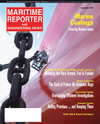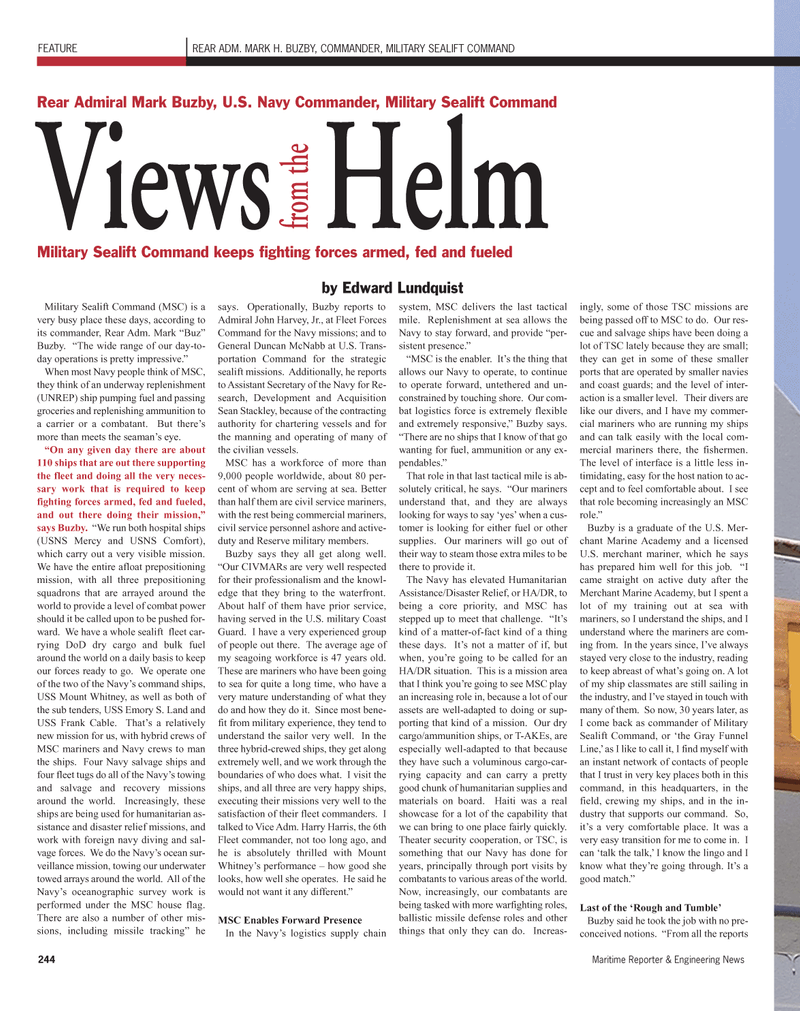
Page 24: of Maritime Reporter Magazine (September 2010)
Marine Propulsion Edition
Read this page in Pdf, Flash or Html5 edition of September 2010 Maritime Reporter Magazine
Military Sealift Command (MSC) is a very busy place these days, according to its commander, Rear Adm. Mark “Buz”
Buzby. “The wide range of our day-to- day operations is pretty impressive.”
When most Navy people think of MSC, they think of an underway replenishment (UNREP) ship pumping fuel and passing groceries and replenishing ammunition to a carrier or a combatant. But there’s more than meets the seaman’s eye. “On any given day there are about 110 ships that are out there supporting the fleet and doing all the very neces- sary work that is required to keep fighting forces armed, fed and fueled, and out there doing their mission,” says Buzby. “We run both hospital ships (USNS Mercy and USNS Comfort), which carry out a very visible mission.
We have the entire afloat prepositioning mission, with all three prepositioning squadrons that are arrayed around the world to provide a level of combat power should it be called upon to be pushed for- ward. We have a whole sealift fleet car- rying DoD dry cargo and bulk fuel around the world on a daily basis to keep our forces ready to go. We operate one of the two of the Navy’s command ships,
USS Mount Whitney, as well as both of the sub tenders, USS Emory S. Land and
USS Frank Cable. That’s a relatively new mission for us, with hybrid crews of
MSC mariners and Navy crews to man the ships. Four Navy salvage ships and four fleet tugs do all of the Navy’s towing and salvage and recovery missions around the world. Increasingly, these ships are being used for humanitarian as- sistance and disaster relief missions, and work with foreign navy diving and sal- vage forces. We do the Navy’s ocean sur- veillance mission, towing our underwater towed arrays around the world. All of the
Navy’s oceanographic survey work is performed under the MSC house flag.
There are also a number of other mis- sions, including missile tracking” he says. Operationally, Buzby reports to
Admiral John Harvey, Jr., at Fleet Forces
Command for the Navy missions; and to
General Duncan McNabb at U.S. Trans- portation Command for the strategic sealift missions. Additionally, he reports to Assistant Secretary of the Navy for Re- search, Development and Acquisition
Sean Stackley, because of the contracting authority for chartering vessels and for the manning and operating of many of the civilian vessels.
MSC has a workforce of more than 9,000 people worldwide, about 80 per- cent of whom are serving at sea. Better than half them are civil service mariners, with the rest being commercial mariners, civil service personnel ashore and active- duty and Reserve military members.
Buzby says they all get along well. “Our CIVMARs are very well respected for their professionalism and the knowl- edge that they bring to the waterfront.
About half of them have prior service, having served in the U.S. military Coast
Guard. I have a very experienced group of people out there. The average age of my seagoing workforce is 47 years old.
These are mariners who have been going to sea for quite a long time, who have a very mature understanding of what they do and how they do it. Since most bene- fit from military experience, they tend to understand the sailor very well. In the three hybrid-crewed ships, they get along extremely well, and we work through the boundaries of who does what. I visit the ships, and all three are very happy ships, executing their missions very well to the satisfaction of their fleet commanders. I talked to Vice Adm. Harry Harris, the 6th
Fleet commander, not too long ago, and he is absolutely thrilled with Mount
Whitney’s performance – how good she looks, how well she operates. He said he would not want it any different.”
MSC Enables Forward Presence
In the Navy’s logistics supply chain system, MSC delivers the last tactical mile. Replenishment at sea allows the
Navy to stay forward, and provide “per- sistent presence.” “MSC is the enabler. It’s the thing that allows our Navy to operate, to continue to operate forward, untethered and un- constrained by touching shore. Our com- bat logistics force is extremely flexible and extremely responsive,” Buzby says. “There are no ships that I know of that go wanting for fuel, ammunition or any ex- pendables.”
That role in that last tactical mile is ab- solutely critical, he says. “Our mariners understand that, and they are always looking for ways to say ‘yes’ when a cus- tomer is looking for either fuel or other supplies. Our mariners will go out of their way to steam those extra miles to be there to provide it.
The Navy has elevated Humanitarian
Assistance/Disaster Relief, or HA/DR, to being a core priority, and MSC has stepped up to meet that challenge. “It’s kind of a matter-of-fact kind of a thing these days. It’s not a matter of if, but when, you’re going to be called for an
HA/DR situation. This is a mission area that I think you’re going to see MSC play an increasing role in, because a lot of our assets are well-adapted to doing or sup- porting that kind of a mission. Our dry cargo/ammunition ships, or T-AKEs, are especially well-adapted to that because they have such a voluminous cargo-car- rying capacity and can carry a pretty good chunk of humanitarian supplies and materials on board. Haiti was a real showcase for a lot of the capability that we can bring to one place fairly quickly.
Theater security cooperation, or TSC, is something that our Navy has done for years, principally through port visits by combatants to various areas of the world.
Now, increasingly, our combatants are being tasked with more warfighting roles, ballistic missile defense roles and other things that only they can do. Increas- ingly, some of those TSC missions are being passed off to MSC to do. Our res- cue and salvage ships have been doing a lot of TSC lately because they are small; they can get in some of these smaller ports that are operated by smaller navies and coast guards; and the level of inter- action is a smaller level. Their divers are like our divers, and I have my commer- cial mariners who are running my ships and can talk easily with the local com- mercial mariners there, the fishermen.
The level of interface is a little less in- timidating, easy for the host nation to ac- cept and to feel comfortable about. I see that role becoming increasingly an MSC role.”
Buzby is a graduate of the U.S. Mer- chant Marine Academy and a licensed
U.S. merchant mariner, which he says has prepared him well for this job. “I came straight on active duty after the
Merchant Marine Academy, but I spent a lot of my training out at sea with mariners, so I understand the ships, and I understand where the mariners are com- ing from. In the years since, I’ve always stayed very close to the industry, reading to keep abreast of what’s going on. A lot of my ship classmates are still sailing in the industry, and I’ve stayed in touch with many of them. So now, 30 years later, as
I come back as commander of Military
Sealift Command, or ‘the Gray Funnel
Line,’ as I like to call it, I find myself with an instant network of contacts of people that I trust in very key places both in this command, in this headquarters, in the field, crewing my ships, and in the in- dustry that supports our command. So, it’s a very comfortable place. It was a very easy transition for me to come in. I can ‘talk the talk,’ I know the lingo and I know what they’re going through. It’s a good match.”
Last of the ‘Rough and Tumble’
Buzby said he took the job with no pre- conceived notions. “From all the reports
FEATURE REAR ADM. MARK H. BUZBY, COMMANDER, MILITARY SEALIFT COMMAND
Views Helm 244 Maritime Reporter & Engineering News
Rear Admiral Mark Buzby, U.S. Navy Commander, Military Sealift Command
Military Sealift Command keeps fighting forces armed, fed and fueled by Edward Lundquist fr om the

 23
23

 25
25
